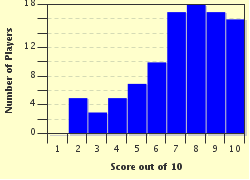Quiz Answer Key and Fun Facts
1. This flightless bird looked like an oversize ostrich. It lived on Madagascar until 300-400 years ago. What was it?
2. This little toad, named for its bright color, was rarely seen but often heard about, as it was used to represent the loss of biodiversity and amphibian extinction. It was last seen around 1989, is now declared extinct, and we don't really know why. What toad was it?
3. This huge European cow or bull was the wild ancestor of modern tame cattle, but went extinct 400 years ago. What was it?
4. This flightless bird looked like a penguin with a heavy, hooked bill. It lived on rocky coastlines of the North Atlantic, but was hunted to death in the 19th Century. What was it?
5. Another Madagascar native, this creature was smaller than normal but still liked to wallow in mud and water. Officially, it died out 1,000 years ago, but some sightings were recorded into the 19th century. What was it?
6. What extinct bird in the eastern US looked like it might have said "Polly want a cracker?" if it were just a little bigger?
7. Picture a dog-like animal that carries its young in a pouch. It's extinct, but what was it?
8. You've probably heard of this big, flightless pigeon, that became extinct in the 17th century because it was too stupid to run from hunters. It has become the poster child for recent extinctions. What was it?
9. Charles Darwin warned that this animal would become extinct soon, on his trip to study island species. What was the first canid (dog-like animal) to become extinct in modern times?
10. This chicken-like bird fed many settlers in the eastern U.S. It might have even been used instead of wild turkey at early Thanksgiving meals. But now it's gone. What was it?
Source: Author
littlepup
This quiz was reviewed by FunTrivia editor
guitargoddess before going online.
Any errors found in FunTrivia content are routinely corrected through our feedback system.

